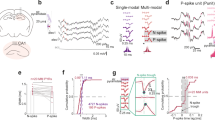Abstract
THE present communication deals with the resting and action potentials of the nerve cell body of the frog dorsal root ganglion immersed in barium-rich media. Dorsal root ganglia were removed from the ventral side of the vertebræ of a Rana pipiens together with nerves 5–10 mm. long on both sides. The preparation was immersed in a sodium free solution containing 80 mM barium chloride, 2 mM potassium bicarbonate and 1.5 mM calcium chloride. On penetration of the nerve cells with a hyperfine glass-pipette electrode filled with 3 M potassium chloride, it was sometimes found that the potential of the microelectrode suddenly rose by 20–40 mV. without being accompanied by any appreciable rise in the electrode resistance. There were also many cells which showed a resting potential (40–70 mV.) of the ordinary (that is, negative) sign.
This is a preview of subscription content, access via your institution
Access options
Subscribe to this journal
Receive 51 print issues and online access
$199.00 per year
only $3.90 per issue
Buy this article
- Purchase on Springer Link
- Instant access to full article PDF
Prices may be subject to local taxes which are calculated during checkout
Similar content being viewed by others
References
Spyropoulos, C. S., J. Gen. Physiol., 40, 19 (1956).
Tasaki, I., J. Physiol. (London) (in the press).
Author information
Authors and Affiliations
Rights and permissions
About this article
Cite this article
TASAKI, I. Resting and Action Potentials of Reversed Polarity in Frog Nerve Cells. Nature 184, 1574–1575 (1959). https://doi.org/10.1038/1841574a0
Issue Date:
DOI: https://doi.org/10.1038/1841574a0
This article is cited by
-
Evidence for initiation of calcium spikes in C-cells of the rabbit nodose ganglion
Pfl�gers Archiv European Journal of Physiology (1982)
-
Ba++ induced square-shaped potential waves in molluscan neurones
Experientia (1977)
-
Hyperpolarization of a Neurone Membrane by Barium
Nature (1964)
-
Effects of Calcium Ions on Prolonged Action Potentials and Hyperpolarizing Responses
Nature (1963)
-
Action potentials of reversed polarity in Purkinje fibers of dog heart
Die Naturwissenschaften (1960)
Comments
By submitting a comment you agree to abide by our Terms and Community Guidelines. If you find something abusive or that does not comply with our terms or guidelines please flag it as inappropriate.



